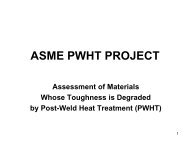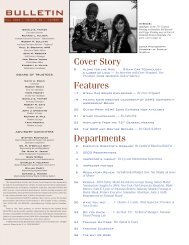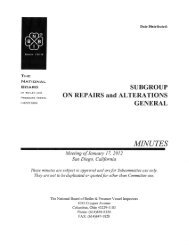Subject: - The National Board of Boiler and Pressure Vessel Inspectors
Subject: - The National Board of Boiler and Pressure Vessel Inspectors
Subject: - The National Board of Boiler and Pressure Vessel Inspectors
You also want an ePaper? Increase the reach of your titles
YUMPU automatically turns print PDFs into web optimized ePapers that Google loves.
NBIC Sub-Group Repairs & Alterations<br />
<strong>Subject</strong>: Exclusive use <strong>of</strong> VT is prohibited as an alternative to pressure testing<br />
NB-Item number:<br />
Explanation <strong>of</strong><br />
assignment needed:<br />
PR08-0306 NB item: NB08-1301<br />
See narrative originally provided by Darryl Peetz.<br />
Without some exclusive provisions for VT-examination, escalated repair costs <strong>and</strong> Inspector<br />
involvement may be required without any appreciable gain in safety realized. A VT-examination<br />
may provide more meaningful results than instituting an initial service leak test; not prohibited by<br />
some codes. A VT-examination during welding may be more meaningful than a surface NDEexamination<br />
method.<br />
Assigned to: Mike Webb, Jim Larson, Bob Wielgoszinski<br />
Background:<br />
<strong>The</strong> “Exclusive use <strong>of</strong> VT-examination” was not permitted after being brought before the Committee <strong>and</strong> passed as item NB04-0203. Through the<br />
public review process, PR08-0306 was initiated after several comments were received. After review in Sub-group RA, this new item was initiated to<br />
review the premise <strong>of</strong> accepting repairs <strong>and</strong> / or alterations using only a VT-examination method.<br />
Existing Text in ’08-addenda Proposed Revision Rationale<br />
Notes during discussion<br />
Part 3,<br />
4.4.1 TEST OR EXAMINATION<br />
METHODS APPLICABLE<br />
TO REPAIRS<br />
Section 4.4.1-e<br />
e) Nondestructive Examination<br />
NDE may be conducted.<br />
Exclusive use <strong>of</strong> Visual<br />
Examination (VT) shall not be<br />
permitted. NDE methods used<br />
shall be suitable for providing<br />
meaningful results to verify the<br />
integrity <strong>of</strong> the repair.<br />
Part 3,<br />
4.4.1 TEST OR EXAMINATION<br />
METHODS APPLICABLE TO<br />
REPAIRS<br />
Section 4.4.1-e<br />
e) Nondestructive Examination<br />
NDE may be conducted when pressure<br />
testing is not practicable. NDE methods<br />
used shall be suitable for providing<br />
meaningful results to verify the integrity<br />
<strong>of</strong> the repair. Exclusive use <strong>of</strong> Visual<br />
Examination (VT) is only permitted with<br />
the following considerations:<br />
1. When a pressure test or alternative<br />
NDE methods are not practicable,<br />
exclusive use <strong>of</strong> direct Visual<br />
Examination (VT) as an NDE method<br />
shall be limited to routine repairs, as<br />
identified in 3.3.2.<br />
2. For each repair being considered,<br />
the exclusive use <strong>of</strong> direct VT-as an<br />
NDE method shall be acceptable to<br />
the Inspector, <strong>and</strong> where required,<br />
the Jurisdiction.<br />
3. As a minimum, VT-examination shall<br />
be performed after the root weld<br />
layer or first-pass is deposited, <strong>and</strong><br />
<strong>The</strong> proposed revision <strong>of</strong>fers some<br />
guidance currently found in ASME B31.1.<br />
As proposed (e-3), VT-examination at the<br />
1 st layer & final weld surface represents<br />
100% more examination than required by<br />
original Code in lieu <strong>of</strong> the pressure test.<br />
Some boiler designs do not lend<br />
themselves to pressure tests (e.g. Reheat<br />
Superheater). Availability <strong>of</strong> NDEcontractors<br />
enlisting alternative volumetric<br />
examination methods is at times uncertain<br />
leaving no alternative in complying with<br />
the NBIC.<br />
Other NDE methods recognized by the<br />
NBIC represent enhanced VT using dye<br />
penetrant or fluorescent magnetic particle<br />
<strong>and</strong> are surface or slightly subsurface<br />
NDE-methods.<br />
PT/MT NDE methods may not represent<br />
meaningful results due to limited access<br />
or other influences negating their use<br />
such as flammability <strong>of</strong> sprays <strong>and</strong><br />
solvents in a confined space. (Example:<br />
Steam drum liner attachment weld to a<br />
Superheat outlet tube stub in a CEdesigned<br />
Controlled Circulation boiler.<br />
Very limited room <strong>and</strong> can not verify<br />
tightness with a pressure test)<br />
VT-examination by a certified individual<br />
(e.g. QC-1-CWI) with established<br />
Repairs in some areas <strong>of</strong> the<br />
country are greatly influenced by<br />
quick returns to service in order<br />
to protect equipment from<br />
freezing. This alternative to<br />
pressure testing better protects<br />
the owner, equipment, <strong>and</strong><br />
reduces safety risk by mitigating<br />
freezing situations.<br />
4.2 - a) identifies the<br />
acceptance criteria shall<br />
be in accordance with the<br />
original code <strong>of</strong><br />
construction.<br />
1
NBIC Sub-Group Repairs & Alterations<br />
the final weld surface. Other weld<br />
layers shall be examined as<br />
identified by the Inspector <strong>and</strong>,<br />
where required, the jurisdiction.<br />
Also….<br />
Part 3<br />
4.4.2 TEST OR EXAMINATION<br />
METHODS APPLICABLE<br />
TO ALTERATIONS<br />
Section 4.4.2-c<br />
c) Nondestructive Examination<br />
Nondestructive examination<br />
(NDE) may be conducted when<br />
contamination <strong>of</strong> the pressure<br />
retaining item by liquids is<br />
possible or when pressure testing<br />
is not practicable. Concurrence <strong>of</strong><br />
the owner shall be obtained in<br />
addition to the Inspector <strong>and</strong><br />
jurisdiction, where required.<br />
Exclusive use <strong>of</strong> Visual<br />
Examination (VT) shall not be<br />
permitted. In all cases NDE<br />
methods or combination <strong>of</strong><br />
methods used shall be suitable<br />
for providing meaningful results to<br />
verify the integrity <strong>of</strong> the<br />
alteration.<br />
4. Personnel completing direct VTexaminations<br />
shall be qualified <strong>and</strong><br />
certified in accordance with<br />
paragraph 4.2- b), AWS QC-1, or<br />
any nationally recognized st<strong>and</strong>ard.<br />
Visual acuity shall be demonstrated<br />
using as a minimum, st<strong>and</strong>ard J-2<br />
letters on st<strong>and</strong>ard Jaeger test type<br />
charts for near vision.<br />
5. VT-examination shall be performed<br />
in accordance with a written<br />
procedure meeting the procedure<br />
<strong>and</strong> reporting requirements listed in<br />
the original code <strong>of</strong> construction or<br />
ASME Section V, Article 9.<br />
Part 3<br />
4.4.2 TEST OR EXAMINATION<br />
METHODS APPLICABLE TO<br />
ALTERATIONS<br />
Section 4.4.2-c<br />
c) Nondestructive Examination<br />
Nondestructive examination (NDE) may<br />
be conducted when contamination <strong>of</strong> the<br />
pressure retaining item by liquids is<br />
possible or when pressure testing is not<br />
practicable. Concurrence <strong>of</strong> the owner<br />
shall be obtained in addition to the<br />
Inspector, <strong>and</strong> where required, the<br />
Jurisdiction. Exclusive use <strong>of</strong> Visual<br />
Examination (VT) shall not be permitted. In<br />
all cases NDE methods or combination <strong>of</strong><br />
methods used shall be suitable for<br />
providing meaningful results to verify the<br />
integrity <strong>of</strong> the alteration.<br />
acceptance criteria <strong>and</strong> a procedure<br />
w/reporting requirements represents inprocess<br />
controls suggested by other NDEmethods<br />
while affording an alternative to<br />
high cost / limited availability NDE<br />
personnel. <strong>The</strong> QC-1 type person is<br />
certified by an in-house program &<br />
described in the quality manual.<br />
Qualification <strong>of</strong> NDE-personnel per 4.2 (b)<br />
in accordance with requirements <strong>of</strong> the<br />
original code <strong>of</strong> construction may follow<br />
ASME Section V, article 9 that in turn<br />
references article I & allows ASNT-TC-1A<br />
or ASNT CP-189. VT-examination per<br />
Section V @ Article 9 identifies near<br />
distance acuity to reading st<strong>and</strong>ard J-1<br />
letters on st<strong>and</strong>ard Jaeger-test charts for<br />
near vision. This exceeds requirements <strong>of</strong><br />
ASNT TC 1A, CP-189, <strong>and</strong> AWS QC-1<br />
requirements that identify using J-2 letters<br />
on st<strong>and</strong>ard Jaeger-test charts for near<br />
vision. Identifying “st<strong>and</strong>ard J-2<br />
letters” within the paragraph,<br />
establishes uniformity between the<br />
referenced st<strong>and</strong>ards.<br />
Reference to “direct” visual examination<br />
displaces the use <strong>of</strong> binoculars, etc. in<br />
completing the proposed examinations.<br />
Part 3<br />
Section 4.4.2-c<br />
“… <strong>and</strong> where required, the<br />
Jurisdiction.”<br />
Is proposed only for consistency<br />
throughout Part 3 <strong>and</strong> the other<br />
Sections.<br />
@ Proposed 4-<br />
<strong>The</strong> current reference to ASNT-<br />
TC-1A & ASNT CP-189 @ 4.2-<br />
b) for qualifying NDE-personnel,<br />
could be confusing when<br />
referenced to an “original code<br />
<strong>of</strong> construction” such as ASME<br />
Section V, Article 9 which<br />
identifies near distance acuity to<br />
st<strong>and</strong>ard J-1 letters on st<strong>and</strong>ard<br />
Jaeger test-type charts.<br />
Additionally, the reference @<br />
4.2-b) to “qualified <strong>and</strong> certified”<br />
personnel does not currently<br />
extend to AWS QC-1 or another<br />
nationally recognized st<strong>and</strong>ard.<br />
<strong>The</strong>refore the “qualified &<br />
certified” -statement is added to<br />
4.4.1 –e) 4. to clarify the<br />
requirement.<br />
By identifying the st<strong>and</strong>ard J-2<br />
letters, the referenced Section<br />
V-Code <strong>and</strong> st<strong>and</strong>ards are<br />
aligned.<br />
@ Proposed 5-<br />
<strong>The</strong> proposed language is to say,<br />
the written procedure & reporting<br />
is to meet the listed<br />
requirements, “like” those<br />
identified in ASME Section V,<br />
Article 9.<br />
ASME Section V, Article 9 would<br />
serve as a framework to develop<br />
an NDT-procedure with reporting<br />
requirements.<br />
<strong>The</strong> reference to, “original code<br />
<strong>of</strong> construction” is already<br />
extended to represent as<br />
applicable, the construction<br />
st<strong>and</strong>ard used to fabricate the<br />
pressure retaining item @ 3.2.1.<br />
To add a reference to<br />
construction “st<strong>and</strong>ard” would be<br />
redundant to this noted<br />
underst<strong>and</strong>ing.<br />
2








